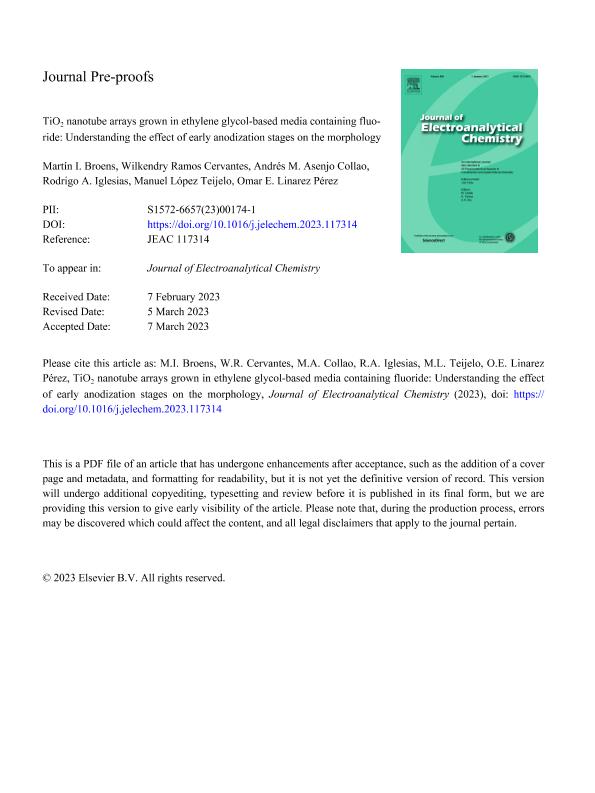Artículo
TiO2 nanotube arrays grown in ethylene glycol-based media containing fluoride: Understanding the effect of early anodization stages on the morphology
Broens, Martin Ignacio ; Ramos Cervantes, Wilkendry
; Ramos Cervantes, Wilkendry ; Asenjo Collao, Andrés Matías
; Asenjo Collao, Andrés Matías ; Iglesias, Rodrigo Alejandro
; Iglesias, Rodrigo Alejandro ; Lopez Teijelo, Manuel
; Lopez Teijelo, Manuel ; Linarez Pérez, Omar Ezequiel
; Linarez Pérez, Omar Ezequiel
 ; Ramos Cervantes, Wilkendry
; Ramos Cervantes, Wilkendry ; Asenjo Collao, Andrés Matías
; Asenjo Collao, Andrés Matías ; Iglesias, Rodrigo Alejandro
; Iglesias, Rodrigo Alejandro ; Lopez Teijelo, Manuel
; Lopez Teijelo, Manuel ; Linarez Pérez, Omar Ezequiel
; Linarez Pérez, Omar Ezequiel
Fecha de publicación:
04/2023
Editorial:
Elsevier Science SA
Revista:
Journal of Electroanalytical Chemistry
ISSN:
1572-6657
Idioma:
Inglés
Tipo de recurso:
Artículo publicado
Clasificación temática:
Resumen
In this work, we develop a phenomenological model describing the growth of TiO2 nanotube arrays (NTA-TiO2) by titanium anodization in ethylene glycol-based electrolytes containing fluoride. NTA-TiO2 formation is described in terms of the well-known High-Field mechanism (HFM) considering film thinning by dissolution, and the electronic current contribution according to the Oxygen Bubble Mold (OBM) model, as it has been previously reported. For the first time, the inclusion of the nucleation of oxygen bubbles as the rate determining step at early anodization times is considered. By simultaneous fitting of the potentiostatic j/t profiles and the time evolution of morphological features such as pore radius, layer thickness and density of pores, the behavior observed for several experimental conditions is accurately described, in contrast to previously reported Field Assisted Dissolution (FAD) and OBM models. Proposed model allows obtaining physical and phenomenological information concerning the formation and growth of nanoporous oxide films as well as their morphological properties. Results also indicate that fluoride species play a key role at the early anodization stages, determining the subsequent film morphology evolution. Also, conclusive evidence for a chemical-type instead of field-assisted film dissolution process is obtained.
Archivos asociados
Licencia
Identificadores
Colecciones
Articulos(IFEG)
Articulos de INST.DE FISICA ENRIQUE GAVIOLA
Articulos de INST.DE FISICA ENRIQUE GAVIOLA
Articulos(INFIQC)
Articulos de INST.DE INVESTIGACIONES EN FISICO- QUIMICA DE CORDOBA
Articulos de INST.DE INVESTIGACIONES EN FISICO- QUIMICA DE CORDOBA
Citación
Broens, Martin Ignacio; Ramos Cervantes, Wilkendry; Asenjo Collao, Andrés Matías; Iglesias, Rodrigo Alejandro; Lopez Teijelo, Manuel; et al.; TiO2 nanotube arrays grown in ethylene glycol-based media containing fluoride: Understanding the effect of early anodization stages on the morphology; Elsevier Science SA; Journal of Electroanalytical Chemistry; 935; 117314; 4-2023; 1-12
Compartir
Altmétricas



